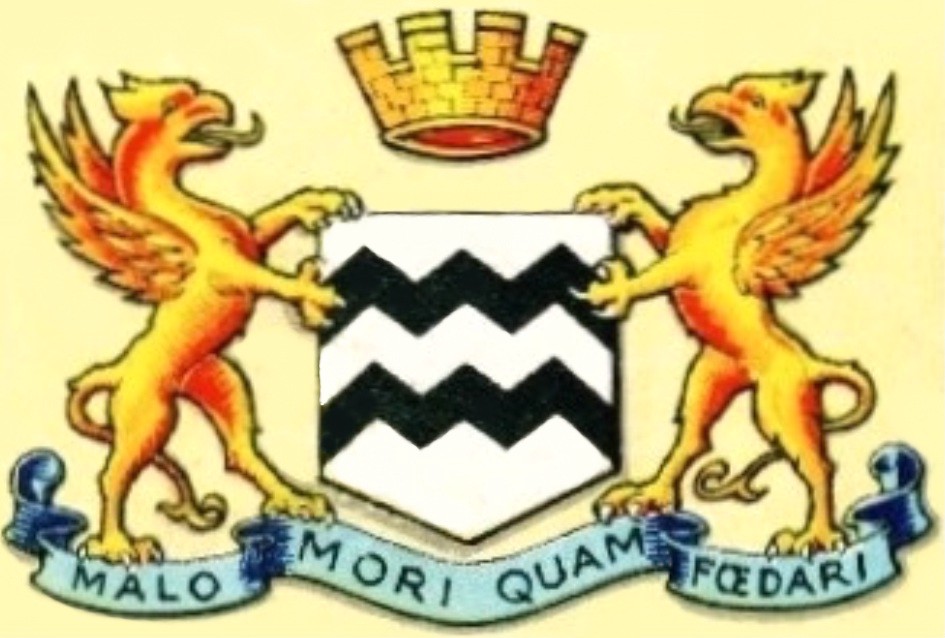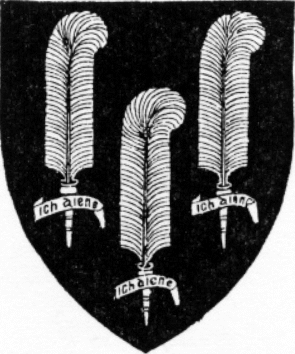

OUDTSHOORN
Province/state: Western Cape; previously Cape Province/Cape Colony.
Division: Oudtshoorn.
Additions: –
Incorporated: 2000, into Oudtshoorn Local Municipality.

Arms taken in to use (amending an earlier version) in February 1961. They may be blazoned:
Arms: Argent, two bars dancetty sable, below a chief or charged with a mural crown gules.
Crest: A flight argent encircled by an annulet gules.
Wreath and mantling: Argent and gules.
Supporters and compartment: A pair of griffins gules, each holding against the shield an ostrich quill plume argent and standing on a compartment representing the veld of the Little Karoo.
Motto: Malo mori quam fœdari.
About the arms:
The basic arms of a pair of bars dancetty are those of the Van Reede van Oudtshoorn family from which the town takes its name (see below).
Baron Pieter van Oudtshoorn belonged to a family (the Van Reedes or Van Rheedes) which took its name from a town that now falls into Germany: Rhede or Rethen in Nordrhein-Westfalen. It nonetheless became powerful in the Netherlands, and Oudtshoorn is one of two towns in South Africa that incorporate the bars dancetty of Rhede into their arms, the other being Paarl, which lies at the foot of the Klein Drakenstein mountains, named after Hendrik Adriaan van Reede tot Drakestein, Lord of Mijdrecht.
The Dutch town of Oudshoorn (now part of Alphen aan den Rijn, in the province of Zuid Holland), seat of the barony, had an altogether different coat of arms: Gules, three horns or. (Note that the spelling is different.)
The chief seems a little irregular, since it contrasts gold (or yellow, in heraldic terms a metal) with silver (or white). It is a device to introduce the mural crown, which signifies that the arms belong to a municipality.
In the illustration a fairly dark shade of red is used, but this appears to be a printer’s error, rather than a deliberate use of murrey or sanguine (dark red colours that occasionally occur in heraldry).
The flight (pair of wings) in the crest is taken from the crest of Baron Van Oudtshoorn, but is placed inside an annulet.
Various members of the Van Rheede family used griffins as supporters, and they are to be seen on the monument to Baron Van Oudtshoorn on the outside of the Groote Kerk in Cape Town and in the arms of Paarl.
The mythical griffin has the body, hindquarters and tail of a lion, but the head, wings and claws (for forelegs) of an eagle, and upright, pointed ears.
The compartment is coloured yellow, and so would seem to represent the arid vegetation of the Little Karoo.
The plumes are unnaturally large, considering the size of both the shield and the griffins, but heraldry has, since the Middle Ages, portrayed ostrich wing plumes as being in this order of size. They were known to Europeans in mediæval times because they were available (in small quantities, and at great price) from sources in North Africa and Arabia.
The motto translates as: “I prefer to die rather than to be disgraced.”
The breach of the colour rule makes it seem unlikely that the arms were registered.

They were taken into use more than a year before the passage of the Heraldry Act and two years before its implementation, and although the College of Arms still technically had authority over South African coats of arms at the time (three months before South Africa became a republic), the republican sympathies of the Town Council make it unlikely that any attempt was made to obtain a grant from London.
It can be seen from the illustration of the old arms that the mural crown was formerly placed above the shield, that the griffins have changed colour and the feathers have been added, but the motto is unchanged.
Feathers and ostriches:
The plumes signify the importance of the ostrich feather trade to Oudtshoorn, especially in the late 19th century and the first decade of the 20th.
The plume feathers are white, and so clearly come from a male of the species Struthio camelus.
The males have glossy black body feathers, but white feathers on the wing and tail tips. Females have grey body feathers, and their wing plume and tail feathers are streaked with black. The pure white of the male wing plumes makes them the most sought-after and highly priced of feathers. They not only have an excellent appearance in their natural condition, but also take dye readily.
Historically ostriches ran wild in the Little Karoo – as well as the Great Karoo and further north. There are three wild races of these birds – one is found in Arabia (where it is virtually extinct), and North Africa, one in East Africa and one in Southern Africa. They are distinguished largely by slight differences in the colour of the naked skin (mainly on the thighs).

Since Classical times the feathers have come from wild birds, mostly in North Africa and Arabia. As mentioned above, they were known in Europe, and were often seen in mediæval coats of arms, perhaps most famously in the arms worn at tournaments by Edward, Prince of Wales (*1330 †1376), known as the Black Prince because of the black surcoat he wore, charged with three silver ostrich plumes. (See here for his proper coat of arms.)
These arms, called by Edward his “shield for peace”, were inherited through his mother, Philippa of Hainaut, from a German ancestor, but the three feathers (together with the accompanying motto, Ich Dien) have since become associated with the Principality of Wales.
It was from wild birds that feathers were first obtained in the Cape Colony, which in 1826 exported 548 kg of feathers valued at £2 805.
But from about 1862 wild birds were tamed, and commercial farming with domesticated birds began in about 1867. Oudtshoorn, incidentally, celebrated the centenary of the ostrich industry in 1963.
Oudtshoorn was uniquely placed to benefit from the trade, because its hot, dry climate combined with a ready availability of irrigation water. It was discovered that the birds thrived on lucerne (known in the United States as alfalfa), which in South Africa usually requires irrigation.
The result of the domestication was a financial boom, mainly in Oudtshoorn but also in other districts.
By 1882 farmers had about 100 000 birds, by 1904 some 358 370 and by 1914 about 750 000.
From 1880 onwards the demand for feathers experienced fluctuations. There was a three-year slump from 1885, and then minor setbacks in 1896 and 1905.
Prices and numbers of birds reached a peak in 1913, when about 450 000 kg of feathers were exported, realising nearly £3 million. During the decade 1903-13 South Africa exported feathers to the value of £19 million.
After gold, wool and diamonds, ostrich feathers were the country's most important export.
At this time Oudtshoorn farmers each kept an average of 600 birds on irrigated lucerne lands, with an income of £5 to £6 per bird each year. Production costs were low, with little labour needed.
Prices of birds rose: proved breeding pairs sold at £500; sometimes £1 000 was refused. Land prices rose to £500 and £1 000 per morgen (just less than a hectare).
Birds were sold out of hand or by tender, and pluckings were sometimes sold six to eight months in advance. The feathers were sorted and auctioned publicly, many of them in Port Elizabeth’s Feather Market Hall.
Virtually all feathers produced in the colony found their way to London. Most were used in Britain and the European Continent, but large quantities were also re-exported to New York. Demand was chiefly for wing feathers.
Changes in fashion, chiefly brought about by the popularity of the motorcar, led to a slump at the beginning of 1914 which was entrenched by the outbreak of war towards the end of the year.
Oudtshoorn entered a slump that it did not emerge from fully until years later. The only boom was in bankruptcies. Many “ostrich feather barons” who had built large and luxurious houses were forced to sell or abandon them. Birds were set loose in large numbers. Some were slaughtered in lieu of wages by farm labourers.
Efforts to revive the industry in the 1920s, which included an expedition to the then colony of Northern Nigeria to capture wild ostriches with better feathers, did not really succeed, although the Nigerian birds resulted in cross-breeding with indigenous bloodlines that produced superior feathers.
Ostrich skins were sent to Europe for tanning, so creating a demand for high-quality ostrich leather goods.
By 1940 virtually all the domesticated ostriches in the world were in Oudtshoorn, but numbers had grown since the slump to around 6 000. Demand for feathers slowly recovered over the second half of the 20th century, and the use of hides and meat increased.
An ostrich abattoir was set up in Oudtshoorn in the 1960s, and a tannery in 1970 which eliminated the need to export raw hides.
In the 1980s large numbers of live ostriches were exported, mostly illegally, and there was a brief boom in ostrich farming in the American south-west. Ostrich farming has again become sustainable elsewhere in South Africa. But Oudtshoorn remains the world capital of the ostrich industry.
About the town:
In 1847 the owners of the farm Hartebeestrivier had their property surveyed and cut up into 500 irrigation erven (plots) along the Grobbelaars River. This river runs north-south through the town, rising in the vicinity of the Cango Caves, and feeds into the Olifants River, which runs east-west past the southern end of the town.
In 1853 a congregation of the Nederduitsche Gereformeerde Kerk was established in the village.
On 26 August 1863 the town of Oudtshoorn was proclaimed, being named after the Baron Pieter van Rheede van Oudtshoorn, who died in January 1773 while at sea, travelling to the Cape to take over as Governor.
Two of his sons were already resident at the Cape, having accompanied him to the colony when he was an official in Cape Town (ending up as Secunde), and the baron’s widow Sophia, too, settled at the Cape. The town was in fact named by the Civil Commissioner of George, Egbertus Bergh, in honour of his wife, Geesje, a granddaughter of the baron.
The town attained municipal status in 1887.
It is the educational centre of the Little Karoo, and also is host to a large military base with an extensive field training area.
It is known for its “ostrich feather palaces”, built during the ostrich feather boom. One, named Pinehurst, was proclaimed a national monument in 1966.
The Afrikaans journalist, politician, storyteller and poet C J Langenhoven lived in Oudtshoorn. His home, Arbeidsgenot, is a museum dedicated to the author.
The local agricultural co-operative, the Klein Karoo-Landboukoöperasie (Little Karoo Agricultural Co-operative), for many years had a monopoly over the trade in ostriches.

Vir Afrikaans, kliek hier
Back to index of municipalities before 2000
Comments, queries: Mike Oettle